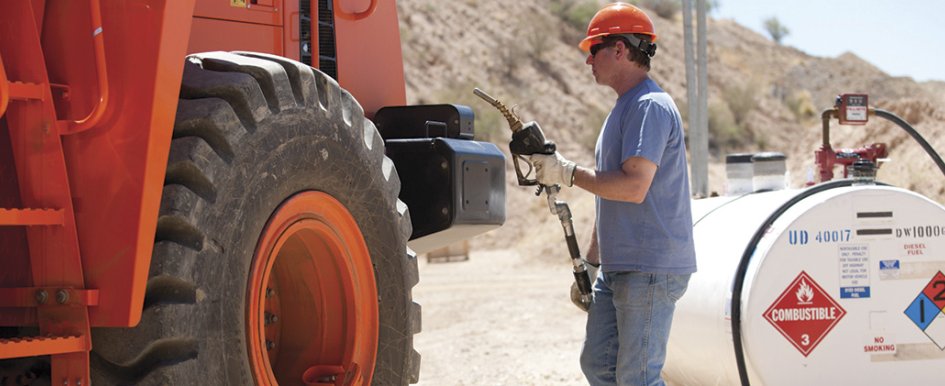
Improvements to Tier 4 engines help burn cleaner fuel and reduce air emissions. To meet U.S. Environmental Protection Agency fuel requirement standards, Tier 4-compliant engines—designed with high-pressure common rail (HPCR) systems and fuel injectors—use ultra-low sulfur diesel (ULSD) fuel.
Water can be introduced into fuel as early as the refinery stage and continue to be present through the terminal, distributor and pump stages. During cold weather conditions, water molecules can detach from diesel molecules, and because they are heavier than diesel molecules, they tend to settle at the bottom of diesel fuel tanks and bulk storage tanks. This can cause potential engine problems in equipment and lead to bacteria growth in the tanks. Today's lower sulfur amounts in diesel fuel multiplies saturates, which increases the tendency of fuel to gel and plug the fuel filter during cold weather conditions.
The following eight fuel management best practices can help reduce machine downtime and costly injector plugging from water, debris and other contaminants found in diesel fuel.
Tip 1: Test bulk fuel tanks every six months.
When storing diesel fuel, the last thing you want is water or other contaminants in your storage tank. Water can degrade the fuel chemical structure and eventually lead to pump, filter and injector problems.
Every six months, you or a professional diesel fuel cleaning and inspection service should test your supply tanks for contaminants. A small amount of water can be removed, but if significant amounts of water or sludge are found, the entire tank should be drained and cleaned. To help monitor your supply tank, keep a preventive maintenance log for the tank that includes maintenance history, filter changes and particle counts.
Tip 2: Keep supply tank fuel filters clean.
Often machines are filled with a 5- or 10-gallon plastic container. How do you know that the container is completely clean or how the fuel was stored before adding it to the container? To bypass these issues, make sure any fuel entering a storage tank passes through a dispensing filter, which will help increase the effectiveness of the machine's fuel filter and help prevent contaminants from entering. Additionally, fuel tank filters should be capped and the tank vent must be filtered. Tank filters typically have a 10-micron-or-fewer fuel filter to help remove moisture as fuel is dispensed through the vent.
Tip 3: Fill machine tanks at the end of each workday.
Diesel fuel can reach high temperatures during the workday. As the machine cools, condensation can form in air gaps. Make sure every machine is filled with diesel fluid at the end of the day to reduce your maintenance costs.
Tip 4: Use 2-micron fuel filters.
Some fuel filters chosen for HPCR engines are highly effective at trapping down to 2-micron contaminants and removing free and emulsified water. No filter will remove all contaminants. However, using the cleanest fuel possible and an efficient fuel filter help minimize the amount of particles entering the machine. Additional fuel filter best practices include:
- Drain the water trap daily.
- Never prefill a new filter during installation.
- Never open fuel connections in the system downstream of the fuel filter.
- Use the manufacturer's recommended replacement fuel filter.
In case contaminated fuel is used in a machine, it is best to purchase an extra fuel filter for every Tier 4, HPCR-engine-equipped machine.
Tip 5: Prepare for cold weather.
Much of the chemistry added in the ULSD fuel can present challenges for diesel fuel suppliers to consistently provide fuel that performs well in cold climates. However, you can utilize cold-weather practices, which include removing trapped water from your machine's fuel filter daily, maintaining your machine's battery state of charge for optimum cranking speed, installing an engine block heater and choosing the best engine oil and hydraulic/hydrostatic oil for the conditions. Maintain a cold-weather kit and follow the cold-starting procedures in your operation and maintenance manual.
Tip 6: Attend a fuel management clinic.
Heavy equipment dealers should be trained on fuel management, and they may host events to accurately relay those tips to you and your operators. On a daily basis, dealers can help assess your situation provide a plan on how to treat any fuel-related issues.
Tip 7: confirm the fuel's cloud point.
A fuel's cloud point is the temperature at which wax begins to drop out of fuel, creating a translucent appearance. The wax forms crystals—50 to 200 microns in size—that can quickly plug the fuel filter. The cloud point from the refinery is based on the geographic location and the time of year that the fuel is intended to be used, so make sure to ask your supplier to confirm the fuel's cloud point.
Tip 8: Identify poor-quality fuel suppliers.
Seeking diesel fuel that meets your needs and choosing a reputable supplier are important. You may have to pay more for clean fuel, but investing in quality fuel that is blended appropriately for the climate may lower your consumption, provide fewer filter changes and deliver longer component life. Two questions you should ask before you buy are: "What micron level of filtration is used on your delivery line?" and "Is this the best fuel available for current conditions?" A good distributor will provide diesel that meets specifications for all environments.
